THR1 mediates GCN4 and CDC4 to link morphogenesis with nutrient sensing and the stress response in Candida albicans
- Authors:
- Yuan‑Ti Lee
- Yi‑Ya Fang
- Yu Wen Sun
- Hsiao‑Chi Hsu
- Shan‑Mei Weng
- Tzu‑Ling Tseng
- Ting‑Hui Lin
- Jia‑Ching Shieh
-
Affiliations: Institute of Medicine and School of Medicine, Chung Shan Medical University, Taichung City 40201, Taiwan, R.O.C., Department of Biomedical Sciences, Chung Shan Medical University, Taichung City 40201, Taiwan, R.O.C. - Published online on: October 12, 2018 https://doi.org/10.3892/ijmm.2018.3930
- Pages: 3193-3208
-
Copyright: © Lee et al. This is an open access article distributed under the terms of Creative Commons Attribution License.
This article is mentioned in:
Abstract
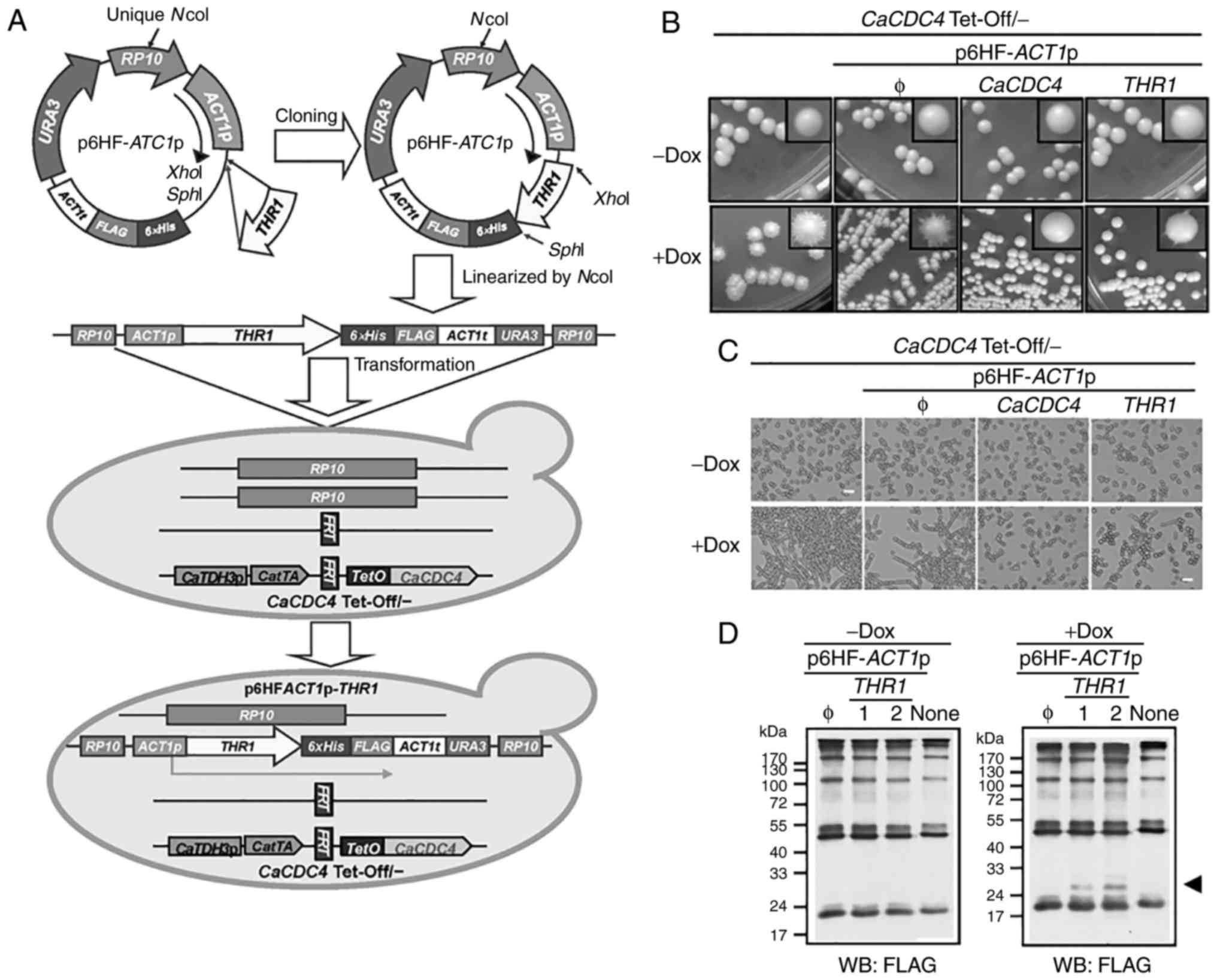 |
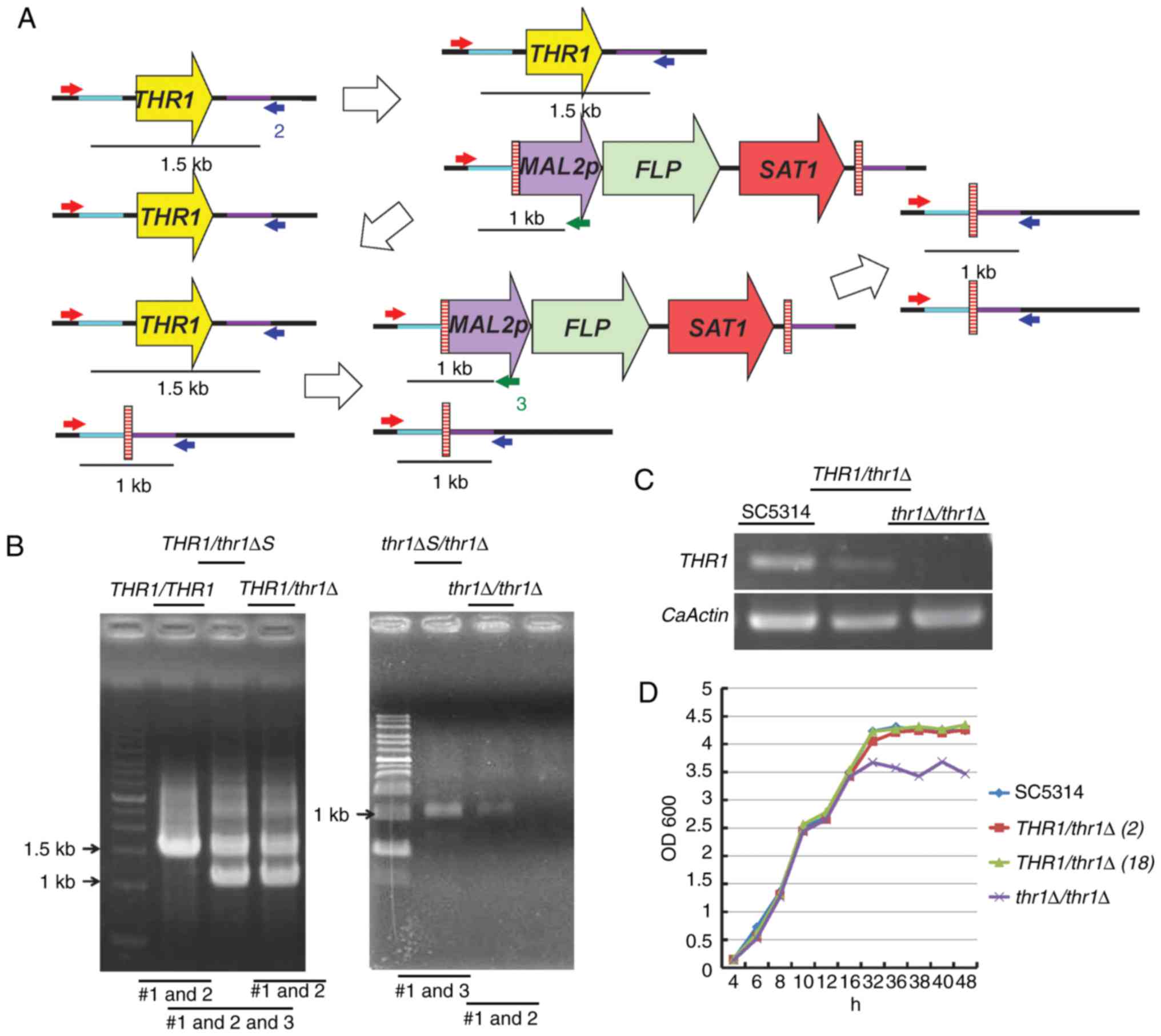 |
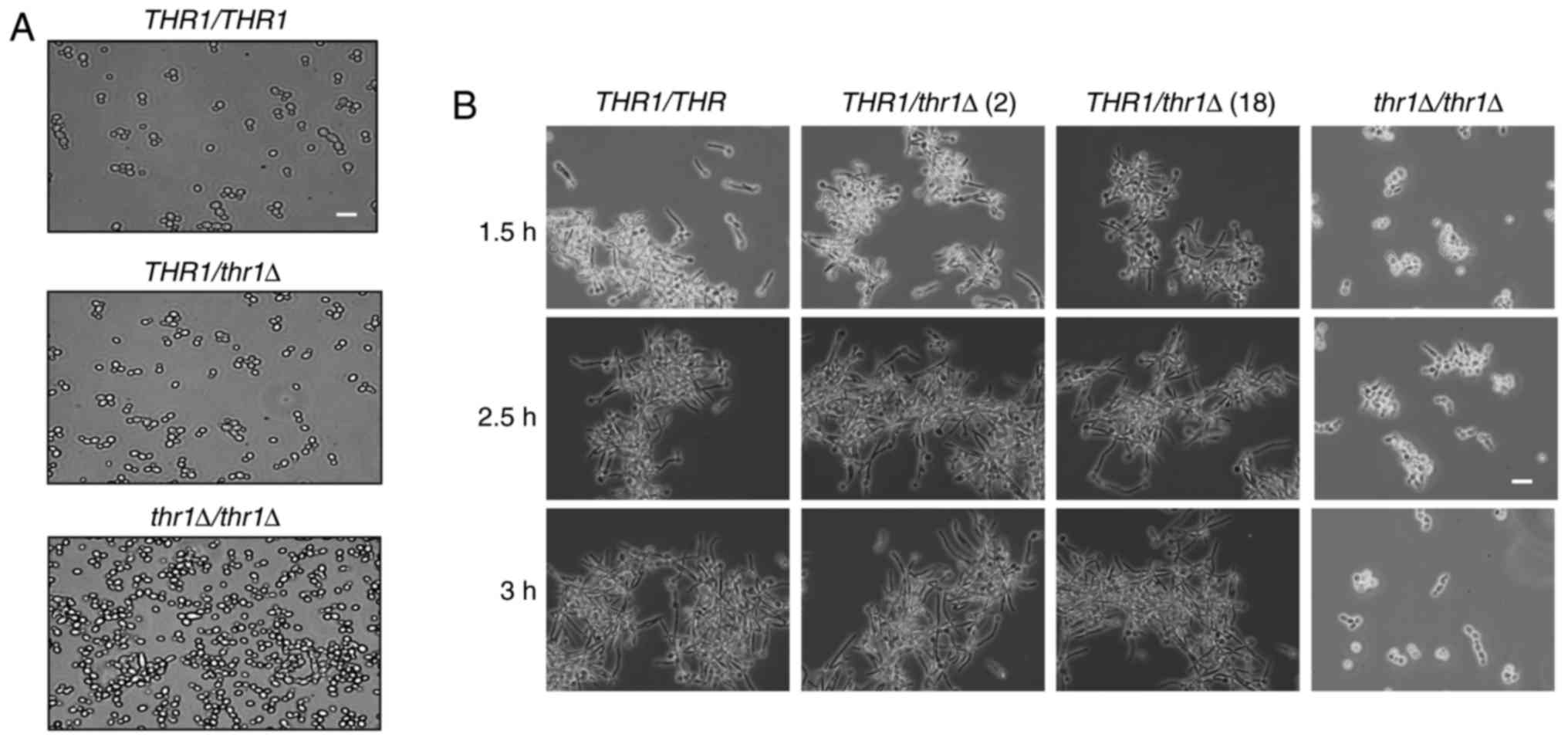 |
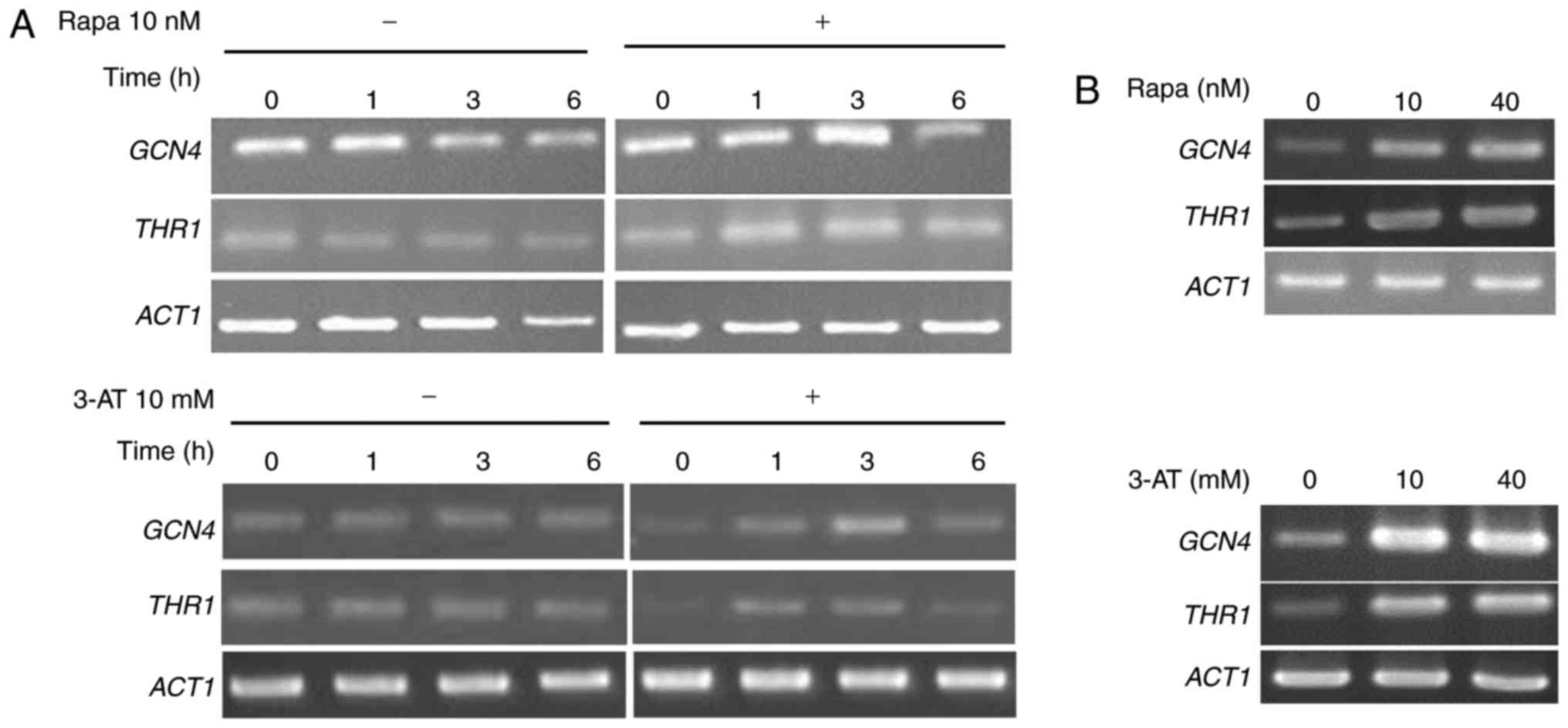 |
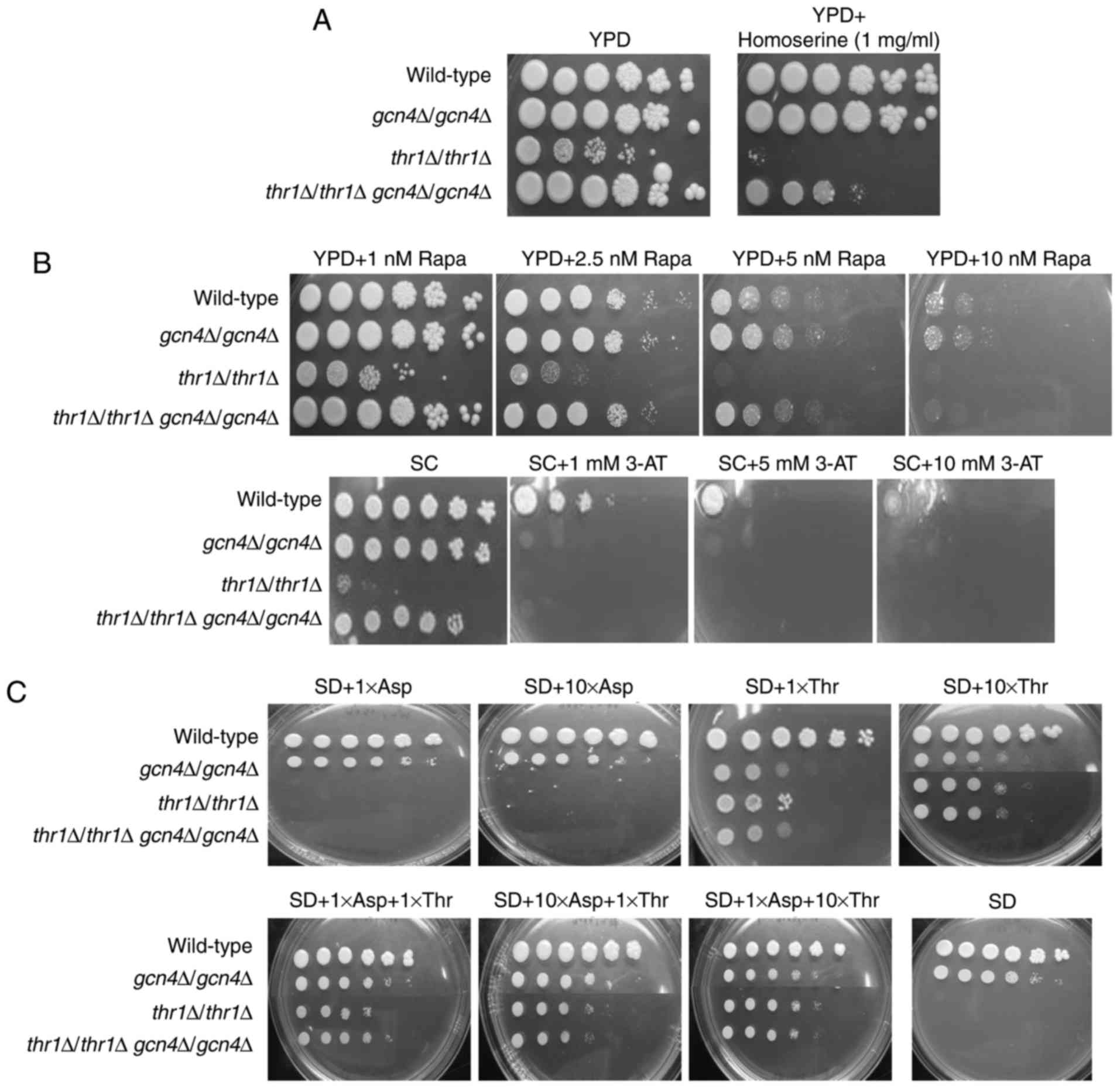 |
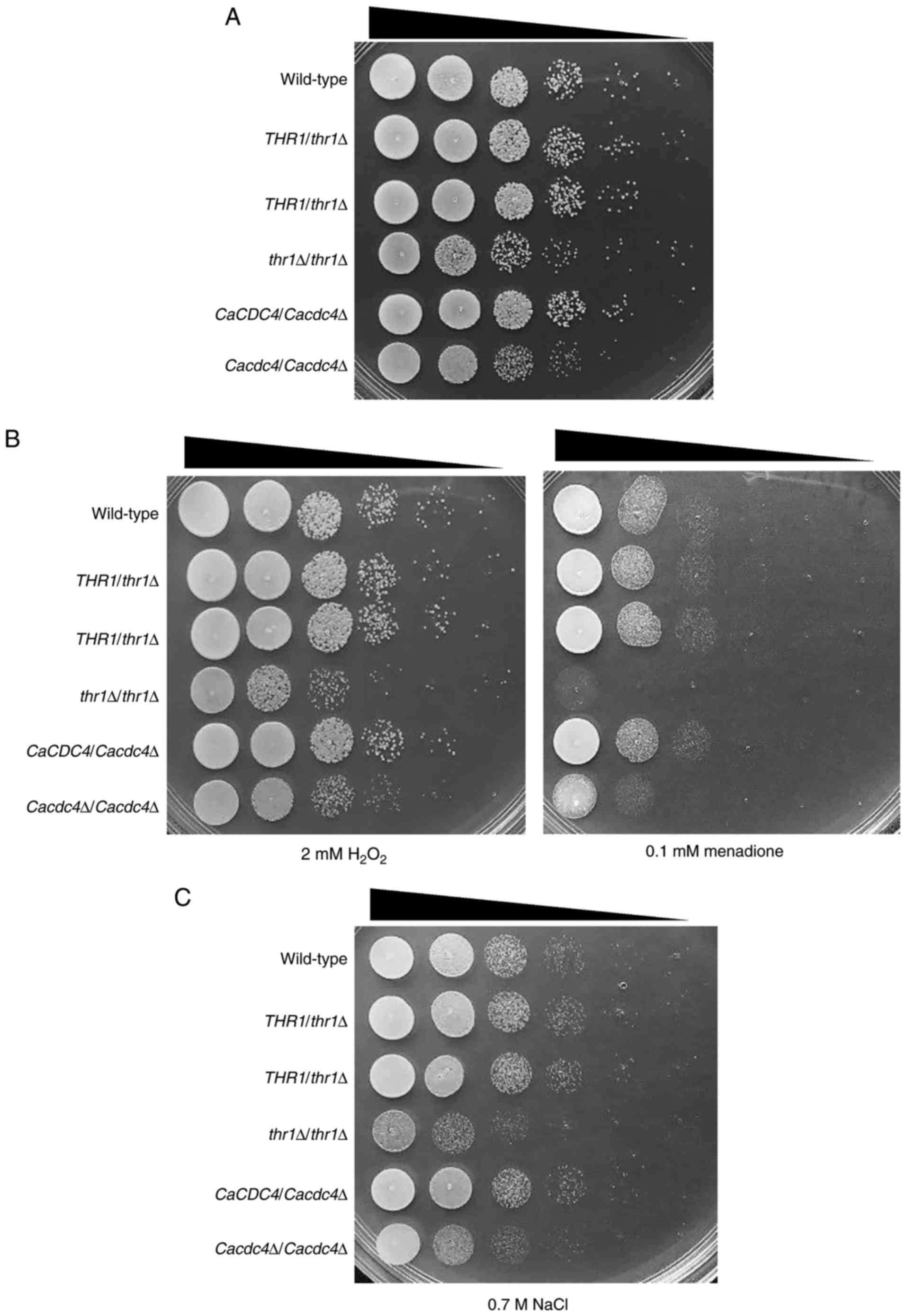 |
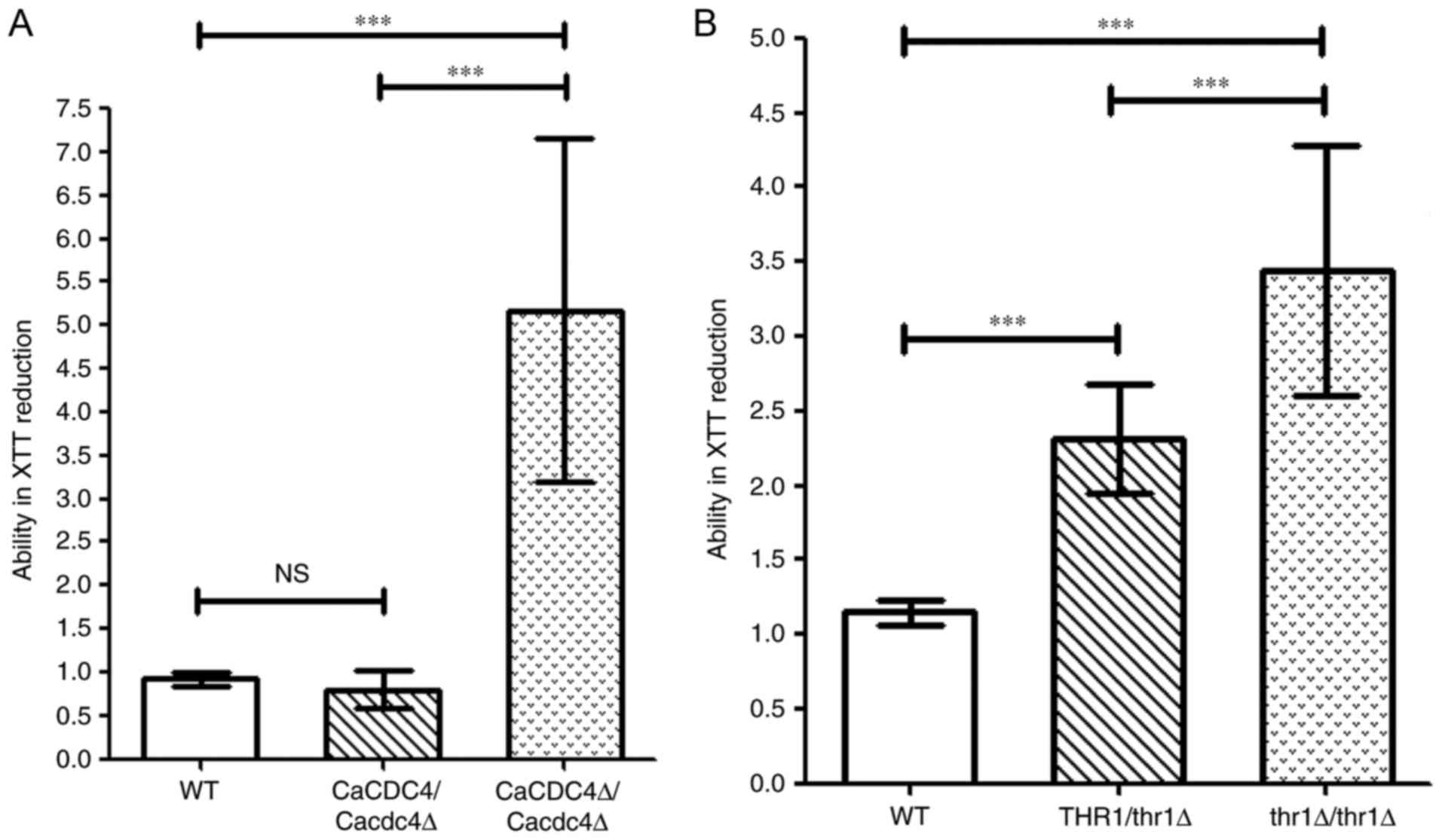 |
|
Ene IV and Bennett RJ: The cryptic sexual strategies of human fungal pathogens. Nat Rev Microbiol. 12:239–251. 2014. View Article : Google Scholar : PubMed/NCBI | |
|
Zhang N, Magee BB, Magee PT, Holland BR, Rodrigues E, Holmes AR, Cannon RD and Schmid J: Selective advantages of a parasexual cycle for the Yeas candida albicans. Genetics. 200:1117–1132. 2015. View Article : Google Scholar : PubMed/NCBI | |
|
Hickman MA, Zeng G, Forche A, Hirakawa MP, Abbey D, Harrison BD, Wang YM, Su CH, Bennett RJ, Wang Y and Berman J: The ‘obligate diploid’ Candida albicans forms mating-competent haploids. Nature. 494:55–59. 2013. View Article : Google Scholar : PubMed/NCBI | |
|
Bennett RJ: The parasexual lifestyle of Candida albicans. Curr Opin Microbiol. 28:10–17. 2015. View Article : Google Scholar : PubMed/NCBI | |
|
Fidel PL Jr: History and update on host defense against vaginal candidiasis. Am J Reprod Immunol. 57:2–12. 2007. View Article : Google Scholar | |
|
Cassone A: Vulvovaginal Candida albicans infections: Pathogenesis, immunity and vaccine prospects. BJOG. 122:785–794. 2015. View Article : Google Scholar | |
|
Patil S, Rao RS, Majumdar B and Anil S: Clinical appearance of oral Candida infection and therapeutic strategies. Front Microbiol. 6:13912015. View Article : Google Scholar | |
|
Garcia-Cuesta C, Sarrion-Pérez MG and Bágan JV: Current treatment of oral candidiasis: A literature review. J Clin Exp Dent. 6:e576-e5822014. | |
|
Pappas PG, Kauffman CA, Andes D, Benjamin DK Jr, Calandra TF, Edwards JE Jr, Filler SG, Fisher JF, Kullberg BJ, Ostrosky-Zeichner L, et al: Clinical practice guidelines for the management of candidiasis: 2009 update by the infectious diseases society of America. Clin Infect Dis. 48:503–535. 2009. View Article : Google Scholar : PubMed/NCBI | |
|
Pappas PG, Kauffman CA, Andes DR, Clancy CJ, Marr KA, Ostrosky-Zeichner L, Reboli AC, Schuster MG, Vazquez JA, Walsh TJ, et al: Clinical practice guideline for the management of candidiasis: 2016 update by the infectious diseases society of America. Clin Infect Dis. 62:e1-e502016. View Article : Google Scholar : | |
|
Teoh F and Pavelka N: How chemotherapy increases the risk of systemic candidiasis in cancer patients: Current paradigm and future directions. Pathogens. 5:pii: E62016. View Article : Google Scholar | |
|
Sudbery P: Morphogenesis of a human fungal pathogen requires septin phosphorylation. Dev Cell. 13:315–316. 2007. View Article : Google Scholar : PubMed/NCBI | |
|
Sudbery P, Gow N and Berman J: The distinct morphogenic states o. Candida albicans Trends Microbiol. 12:317–324. 2004. View Article : Google Scholar | |
|
Whiteway M and Bachewich C: Morphogenesis i. Candida albicans Annu Rev Microbiol. 61:529–553. 2007. View Article : Google Scholar | |
|
Lu Y, Su C and Liu H: Candida albicans hyphal initiation and elongation. Trends Microbiol. 22:707–714. 2014. View Article : Google Scholar : PubMed/NCBI | |
|
Brand A: Hyphal growth in human fungal pathogens and its role in virulence. Int J Microbiol. 2012.517529:2012. | |
|
Navarro-Garcia F, Sánchez M, Nombela C and Pla J: Virulence genes in the pathogenic yeas. Candida albicans FEMS Microbiol Rev. 25:245–268. 2001. View Article : Google Scholar | |
|
Gow NA, van de Veerdonk FL, Brown AJ and Netea MG: Candida albicans morphogenesis and host defence: Discriminating invasion from colonization. Nat Rev Microbiol. 10:112–122. 2011. View Article : Google Scholar : PubMed/NCBI | |
|
Rizzetto L, Weil T and Cavalieri D: Systems level dissection of Candida recognition by dectins: A matter of fungal morphology and site of infection. Pathogens. 4:639–661. 2015. View Article : Google Scholar : PubMed/NCBI | |
|
Berman J and Sudbery PE: Candida albicans: A molecular revolution built on lessons from budding yeast. Nat Rev Genet. 3:918–930. 2002. View Article : Google Scholar : PubMed/NCBI | |
|
Biswas S, Van Dijck P and Datta A: Environmental sensing and signal transduction pathways regulating morphopathogenic determinants of Candida albicans. Microbiol Mol Biol Rev. 71:348–376. 2007. View Article : Google Scholar : PubMed/NCBI | |
|
Martchenko M, Levitin A and Whiteway M: Transcriptional activation domains of the Candida albicans Gcn4p and Gal4p homologs. Eukaryot Cell. 6:291–301. 2007. View Article : Google Scholar : | |
|
Berman J: Morphogenesis and cell cycle progression in Candida albicans. Curr Opin Microbiol. 9:595–601. 2006. View Article : Google Scholar : PubMed/NCBI | |
|
Perez-Martin J, Bardetti P, Castanheira S, de la Torre A and Tenorio-Gómez M: Virulence-specific cell cycle and morphogenesis connections in pathogenic fungi. Semin Cell Dev Biol. 57:93–99. 2016. View Article : Google Scholar : PubMed/NCBI | |
|
Atir-Lande A, Gildor T and Kornitzer D: Role for the SCFCDC4 ubiquitin ligase in Candida albicans morphogenesis. Mol Biol Cell. 16:2772–2785. 2005. View Article : Google Scholar : PubMed/NCBI | |
|
Bensen ES, Clemente-Blanco A, Finley KR, Correa-Bordes J and Berman J: The mitotic cyclins Clb2p and Clb4p affect morphogenesis in Candida albicans. Mol Biol Cell. 16:3387–3400. 2005. View Article : Google Scholar : PubMed/NCBI | |
|
Bensen ES, Filler SG and Berman J: A forkhead transcription factor is important for true hyphal as well as yeast morphogenesis i. Candida albicans Eukaryot Cell. 1:787–798. 2002. View Article : Google Scholar | |
|
Butler DK, All O, Goffena J, Loveless T, Wilson T and Toenjes KA: The GRR1 gene of Candida albicans is involved in the negative control of pseudohyphal morphogenesis. Fungal Genet Biol. 43:573–582. 2006. View Article : Google Scholar : PubMed/NCBI | |
|
Li WJ, Wang YM, Zheng XD, Shi QM, Zhang TT, Bai C, Li D, Sang JL and Wang Y: The F-box protein Grr1 regulates the stability of Ccn1, Cln3 and Hof1 and cell morphogenesis i. Candida albicans Mol Microbiol. 62:212–226. 2006. View Article : Google Scholar | |
|
Shieh JC, White A, Cheng YC and Rosamond J: Identification and functional characterization of Candida albicans CDC4. J Biomed Sci. 12:913–924. 2005. View Article : Google Scholar : PubMed/NCBI | |
|
Agam G, Shamir A, Shaltiel G and Greenberg ML: Myo-inositol-1-phosphate (MIP) synthase: A possible new target for antibipolar drugs. Bipolar Disord. 4(Suppl 1): S15–S20. 2002. View Article : Google Scholar | |
|
Hochstrasser M: Protein degradation or regulation: Ub the judge. Cell. 84:813–815. 1996. View Article : Google Scholar : PubMed/NCBI | |
|
Chin C, Lai WC, Lee TL, Tseng TL and Shieh JC: Dissection of the Candida albicans Cdc4 protein reveals the involvement of domains in morphogenesis and cell flocculation. J Biomed Sci. 20:972013. View Article : Google Scholar : PubMed/NCBI | |
|
Galán-Ladero MA, Blanco-Blanco MT, Hurtado C, Pérez-Giraldo C, Blanco MT and Gómez-Garcia AC: Determination of biofilm production by Candida tropicalis isolated from hospitalized patients and its relation to cellular surface hydrophobicity, plastic adherence and filamentation ability. Yeast. 30:331–339. 2013. View Article : Google Scholar : PubMed/NCBI | |
|
Ramage G, VandeWalle K, López-Ribot JL and Wickes BL: The filamentation pathway controlled by the Efg1 regulator protein is required for normal biofilm formation and development in Candida albicans. FEMS Microbiol Lett. 214:95–100. 2002. View Article : Google Scholar : PubMed/NCBI | |
|
Ryan O, Shapiro RS, Kurat CF, Mayhew D, Baryshnikova A, Chin B, Lin ZY, Cox MJ, Vizeacoumar F, Cheung D, et al: Global gene deletion analysis exploring yeast filamentous growth. Science. 337:1353–1356. 2012. View Article : Google Scholar : PubMed/NCBI | |
|
Kavanaugh NL, Zhang AQ, Nobile CJ, Johnson AD and Ribbeck K: Mucins suppress virulence traits of Candida albicans. MBio. 5:e019112014. View Article : Google Scholar : PubMed/NCBI | |
|
Verstrepen KJ and Klis FM: Flocculation, adhesion and biofilm formation in yeasts. Mol Microbiol. 60:5–15. 2006. View Article : Google Scholar : PubMed/NCBI | |
|
Verstrepen KJ, Reynolds TB and Fink GR: Origins of variation in the fungal cell surface. Nat Rev Microbiol. 2:533–540. 2004. View Article : Google Scholar : PubMed/NCBI | |
|
Tseng TL, Lai WC, Lee TL, Hsu WH, Sun YW, Li WC, Cheng CW and Shieh JC: A role of Candida albicans CDC4 in the negative regulation of biofilm formation. Can J Microbiol. 61:247–255. 2015. View Article : Google Scholar : PubMed/NCBI | |
|
Tseng TL, Lai WC, Jian T, Li C, Sun HF, Way TD and Shieh JC: Affinity purification of Candida albicans CaCdc4-associated proteins reveals the presence of novel proteins involved in morphogenesis. Biochem Biophys Res Commun. 395:152–157. 2010. View Article : Google Scholar : PubMed/NCBI | |
|
Ramos C and Calderón IL: Biochemical evidence that the Saccharomyces cerevisiae THR4 gene encodes threonine synthetase. FEBS Lett. 351:357–359. 1994. View Article : Google Scholar : PubMed/NCBI | |
|
Schultes NP, Ellington AD, Cherry JM and Szostak JW: Saccharomyces cerevisiae homoserine kinase is homologous to prokaryotic homoserine kinases. Gene. 96:177–180. 1990. View Article : Google Scholar : PubMed/NCBI | |
|
Kingsbury JM and McCusker JH: Homoserine toxicity in Saccharomyces cerevisiae and Candida albicans homoserine kinase (thr1Delta) mutants. Eukaryot Cell. 9:717–728. 2010. View Article : Google Scholar : PubMed/NCBI | |
|
Kingsbury JM and McCusker JH: Fungal homoserine kinase (thr1Delta) mutants are attenuated in virulence and die rapidly upon threonine starvation and serum incubation. Eukaryot Cell. 9:729–737. 2010. View Article : Google Scholar : PubMed/NCBI | |
|
Staschke KA, Dey S, Zaborske JM, Palam LR, McClintick JN, Pan T, Edenberg HJ and Wek RC: Integration of general amino acid control and target of rapamycin (TOR) regulatory pathways in nitrogen assimilation in yeast. J Biol Chem. 285:16893–16911. 2010. View Article : Google Scholar : PubMed/NCBI | |
|
Valenzuela L, Aranda C and González A: TOR modulates GCN4-dependent expression of genes turned on by nitrogen limitation. J Bacteriol. 183:2331–2334. 2001. View Article : Google Scholar : PubMed/NCBI | |
|
Conrad M, Schothorst J, Kankipati HN, Van Zeebroeck G, Rubio-Texeira M and Thevelein JM: Nutrient sensing and signaling in the yeas Saccharomyces cerevisiae. FEMS Microbiol Rev. 38:254–299. 2014. View Article : Google Scholar : PubMed/NCBI | |
|
Ljungdahl PO and Daignan-Fornier B: Regulation of amino acid, nucleotide, and phosphate metabolism in Saccharomyces cerevisiae. Genetics. 190:885–929. 2012. View Article : Google Scholar : PubMed/NCBI | |
|
Heitman J, Movva NR and Hall MN: Targets for cell cycle arrest by the immunosuppressant rapamycin in yeast. Science. 253:905–909. 1991. View Article : Google Scholar : PubMed/NCBI | |
|
Kunz J, Henriquez R, Schneider U, Deuter-Reinhard M, Movva NR and Hall MN: Target of rapamycin in yeast, TOR2, is an essential phosphatidylinositol kinase homolog required for G1 progression. Cell. 73:585–596. 1993. View Article : Google Scholar : PubMed/NCBI | |
|
Cruz MC, Goldstein AL, Blankenship J, Del Poeta M, Perfect JR, McCusker JH, Bennani YL, Cardenas ME and Heitman J: Rapamycin and less immunosuppressive analogs are toxic to Candida albicans and Cryptococcus neoformans via FKBP12-dependent inhibition of TOR. Antimicrob Agents Chemother. 45:3162–3170. 2001. View Article : Google Scholar : PubMed/NCBI | |
|
Bastidas RJ, Heitman J and Cardenas ME: The protein kinase Tor1 regulates adhesin gene expression in Candida albicans. PLoS Pathog. 5:e10002942009. View Article : Google Scholar : PubMed/NCBI | |
|
Jones EW and Fink GR: Regulation of amino acid and nucleotide biosynthesis in yeast. Cold Spring Harbor monograph series, The Molecular biology of the yeast Saccharomyces: Metabolism and gene expression. Strathern JN, Jones EW and Broach JR: Cold Spring Harbor Laboratory; Cold Spring Harbor, NY: pp. 6801982 | |
|
Ellenberger TE, Brandl CJ, Struhl K and Harrison SC: The GCN4 basic region leucine zipper binds DNA as a dimer of uninterrupted alpha helices: Crystal structure of the protein-DNA complex. Cell. 71:1223–1237. 1992. View Article : Google Scholar : PubMed/NCBI | |
|
Natarajan K, Meyer MR, Jackson BM, Slade D, Roberts C, Hinnebusch AG and Marton MJ: Transcriptional profiling shows that Gcn4p is a master regulator of gene expression during amino acid starvation in yeast. Mol Cell Biol. 21:4347–4368. 2001. View Article : Google Scholar : PubMed/NCBI | |
|
Hughes JD, Estep PW, Tavazoie S and Church GM: Computational identification of cis-regulatory elements associated with groups of functionally related genes in Saccharomyces cerevisiae. J Mol Biol. 296:1205–1214. 2000. View Article : Google Scholar : PubMed/NCBI | |
|
Meussdoerffer F and Fink GR: Structure and expression of two aminoacyl-tRNA synthetase genes fro. Saccharomyces cerevisiae J Biol Chem. 258:6293–6299. 1983. | |
|
Arndt K and Fink GR: GCN4 protein, a positive transcription factor in yeast, binds general control promoters at all 5 ‘TGACTC 3’ sequences. Proc Natl Acad Sci USA. 83:8516–8520. 1986. View Article : Google Scholar | |
|
Hinnebusch AG: Mechanisms of gene regulation in the general control of amino acid biosynthesis in Saccharomyces cerevisiae. Microbiol Rev. 52:248–273. 1988.PubMed/NCBI | |
|
Albrecht G, Mosch HU, Hoffmann B, Reusser U and Braus GH: Monitoring the Gcn4 protein-mediated response in the yeast Saccharomyces cerevisiae. J Biol Chem. 273:12696–12702. 1998. View Article : Google Scholar : PubMed/NCBI | |
|
Lavoie H, Hogues H and Whiteway M: Rearrangements of the transcriptional regulatory networks of metabolic pathways in fungi. Curr Opin Microbiol. 12:655–663. 2009. View Article : Google Scholar : PubMed/NCBI | |
|
Tripathi G, Wiltshire C, Macaskill S, Tournu H, Budge S and Brown AJ: Gcn4 co-ordinates morphogenetic and metabolic responses to amino acid starvation in Candida albicans. EMBO J. 21:5448–5456. 2002. View Article : Google Scholar : PubMed/NCBI | |
|
Tournu H, Tripathi G, Bertram G, Macaskill S, Mavor A, Walker L, Odds FC, Gow NA and Brown AJ: Global role of the protein kinase Gcn2 in the human pathoge Candida albicans. Eukaryot Cell. 4:1687–1696. 2005. View Article : Google Scholar : PubMed/NCBI | |
|
Hinnebusch AG: The general control of amino acid biosynthetic genes in the yeas Saccharomyces cerevisiae. CRC Crit Rev Biochem. 21:277–317. 1986. View Article : Google Scholar | |
|
Hinnebusch AG and Natarajan K: Gcn4p, a master regulator of gene expression, is controlled at multiple levels by diverse signals of starvation and stress. Eukaryot Cell. 1:22–32. 2002. View Article : Google Scholar : PubMed/NCBI | |
|
Han TL, Cannon RD and Villas-Boas SG: The metabolic basis of Candida albicans morphogenesis and quorum sensing. Fungal Genet Biol. 48:747–763. 2011. View Article : Google Scholar : PubMed/NCBI | |
|
Rawal Y, Qiu H and Hinnebusch AG: Accumulation of a threonine biosynthetic intermediate attenuates general amino acid control by accelerating degradation of Gcn4 via Pho85 and Cdk8. PLoS Genet. 10:e10045342014. View Article : Google Scholar : PubMed/NCBI | |
|
Ernst JF: Transcription factors in Candida albicans-environmental control of morphogenesis. Microbiology. 146:1763–1774. 2000. View Article : Google Scholar | |
|
Murad AM, d’Enfert C, Gaillardin C, Tournu H, Tekaia F, Talibi D, Marechal D, Marchais V, Cottin J and Brown AJ: Transcript profiling in Candida albicans reveals new cellular functions for the transcriptional repressors CaTup1, CaMig1 and CaNrg1. Mol Microbiol. 42:981–993. 2001. View Article : Google Scholar : PubMed/NCBI | |
|
Murad AM, Leng P, Straffon M, Wishart J, Macaskill S, MacCallum D, Schnell N, Talibi D, Marechal D, Tekaia F, et al: NRG1 represses yeast-hypha morphogenesis and hypha-specific gene expression i. Candida albicans EMBO J. 20:4742–4752. 2001. View Article : Google Scholar | |
|
Nantel A, Dignard D, Bachewich C, Harcus D, Marcil A, Bouin AP, Sensen CW, Hogues H, van het Hoog M, Gordon P, et al: Transcription profiling of Candida albicans cells undergoing the yeast-to-hyphal transition. Mol Biol Cell. 13:3452–3465. 2002. View Article : Google Scholar : PubMed/NCBI | |
|
Lo HJ, Köhler JR, DiDomenico B, Loebenberg D, Cacciapuoti A and Fink GR: Nonfilamentous C. albicans mutants are avirulent. Cell. 90:939–949. 1997. View Article : Google Scholar : PubMed/NCBI | |
|
Gillum AM, Tsay EY and Kirsch DR: Isolation of the Candida albicans gene for orotidine-5′-phosphate decarboxylase by complementation of S. cerevisiae ura3 and E. coli pyrF mutations. Mol Gen Genet. 198:179–182. 1984. View Article : Google Scholar | |
|
Wilson RB, Davis D and Mitchell AP: Rapid hypothesis testing with Candida albicans through gene disruption with short homology regions. J Bacteriol. 181:1868–1874. 1999.PubMed/NCBI | |
|
Chen Q, Chen X, Wang Q, Zhang F, Lou Z, Zhang Q and Zhou DX: Structural basis of a histone H3 lysine 4 demethylase required for stem elongation in rice. PLoS Genet. 9:e10032392013. View Article : Google Scholar : PubMed/NCBI | |
|
Warren G and Sherratt D: Incompatibility and transforming efficiency of ColE1 and related plasmids. Mol Gen Genet. 161:39–47. 1978. View Article : Google Scholar : PubMed/NCBI | |
|
Dower WJ, Miller JF and Ragsdale CW: High efficiency transformation of E. coli by high voltage electroporation. Nucleic Acids Res. 16:6127–6145. 1988. View Article : Google Scholar : PubMed/NCBI | |
|
Gietz RD: Yeast transformation by the LiAc/SS carrier DNA/PEG method. Methods Mol Biol. 1205:1–12. 2014. View Article : Google Scholar : PubMed/NCBI | |
|
Becker DM and Lundblad V: Introduction of DNA into yeast cells. Curr Protoc Mol Biol Chapter. 13:Unit13.72001. | |
|
Lai WC, Sun HF, Lin PH, Ho Lin HL and Shieh JC: A new rapid and efficient system with dominant selection developed to inactivate and conditionally express genes in Candida albicans. Curr Genet. 62:213–235. 2016. View Article : Google Scholar | |
|
Kaneko A, Umeyama T, Hanaoka N, Monk BC, Uehara Y and Niimi M: Tandem affinity purification of the Candida albicans septin protein complex. Yeast. 21:1025–1033. 2004. View Article : Google Scholar : PubMed/NCBI | |
|
Reuss O, Vik A, Kolter R and Morschhäuser J: The SAT1 flipper, an optimized tool for gene disruption in Candida albicans. Gene. 341:119–127. 2004. View Article : Google Scholar : PubMed/NCBI | |
|
Shieh JC, Cheng YC, Su MC, Moore M, Choo Y and Klug A: Tailor-made zinc-finger transcription factors activate FLO11 gene expression with phenotypic consequences in the yeas Saccharomyces cerevisiae. PLoS One. 2:e7462007. View Article : Google Scholar | |
|
Liu H, Köhler J and Fink GR: Suppression of hyphal formation in Candida albicans by mutation of a STE12 homolog. Science. 266:1723–1726. 1994. View Article : Google Scholar : PubMed/NCBI | |
|
Gildor T, Shemer R, Atir-Lande A and Kornitzer D: Coevolution of cyclin Pcl5 and its substrate Gcn4. Eukaryot Cell. 4:310–318. 2005. View Article : Google Scholar : PubMed/NCBI | |
|
Garcia-Sanchez S, Aubert S, Iraqui I, Janbon G, Ghigo JM and d’Enfert C: Candida albicans biofilms: A developmental state associated with specific and stable gene expression patterns. Eukaryot Cell. 3:536–545. 2004. View Article : Google Scholar : PubMed/NCBI | |
|
Enjalbert B, Smith DA, Cornell MJ, Alam I, Nicholls S, Brown AJ and Quinn J: Role of the Hog1 stress-activated protein kinase in the global transcriptional response to stress in the fungal pathoge Candida albicans. Mol Biol Cell. 17:1018–1032. 2006. View Article : Google Scholar : | |
|
Blankenship JR, Fanning S, Hamaker JJ and Mitchell AP: An extensive circuitry for cell wall regulation in Candida albicans. PLoS Pathog. 6:e10007522010. View Article : Google Scholar : PubMed/NCBI | |
|
Deveau A, Piispanen AE, Jackson AA and Hogan DA: Farnesol induces hydrogen peroxide resistance in Candida albicans yeast by inhibiting the Ras-cyclic AMP signaling pathway. Eukaryot Cell. 9:569–577. 2010. View Article : Google Scholar : PubMed/NCBI | |
|
Su C, Lu Y and Liu H: Reduced TOR signaling sustains hyphal development in Candida albicans by lowering Hog1 basal activity. Mol Biol Cell. 24:385–397. 2013. View Article : Google Scholar : | |
|
Nelson DE, Randle SJ and Laman H: Beyond ubiquitination: The atypical functions of Fbxo7 and other F-box proteins. Open Biol. 3:1301312013. View Article : Google Scholar : PubMed/NCBI | |
|
Herscovics A and Orlean P: Glycoprotein biosynthesis in yeast. FASEB J. 7:540–550. 1993. View Article : Google Scholar : PubMed/NCBI | |
|
Payne SH and Loomis WF: Retention and loss of amino acid biosynthetic pathways based on analysis of whole-genome sequences. Eukaryot Cell. 5:272–276. 2006. View Article : Google Scholar : PubMed/NCBI | |
|
Goldstein AL and McCusker JH: Development of Saccharomyces cerevisiae as a model pathogen. A system for the genetic identification of gene products required for survival in the mammalian host environment. Genetics. 159:499–513. 2001.PubMed/NCBI | |
|
Kingsbury JM, Yang Z, Ganous TM, Cox GM and McCusker JH: Cryptococcus neoformans Ilv2p confers resistance to sulfometuron methyl and is required for survival at 37 degrees C and in vivo. Microbiology. 150:1547–1558. 2004. View Article : Google Scholar : PubMed/NCBI | |
|
Pascon RC, Ganous TM, Kingsbury JM, Cox GM and McCusker JH: Cryptococcus neoformans methionine synthase: Expression analysis and requirement for virulence. Microbiology. 150:3013–3023. 2004. View Article : Google Scholar : PubMed/NCBI | |
|
Cynober LA: Plasma amino acid levels with a note on membrane transport: Characteristics, regulation, and metabolic significance. Nutrition. 18:761–766. 2002. View Article : Google Scholar : PubMed/NCBI | |
|
Sundaram A and Grant CM: A single inhibitory upstream open reading frame (uORF) is sufficient to regulate Candida albicans GCN4 translation in response to amino acid starvation conditions. RNA. 20:559–567. 2014. View Article : Google Scholar : PubMed/NCBI | |
|
Jia MH, Larossa RA, Lee JM, Rafalski A, Derose E, Gonye G and Xue Z: Global expression profiling of yeast treated with an inhibitor of amino acid biosynthesis, sulfometuron methyl. Physiol Genomics. 3:83–92. 2000. View Article : Google Scholar : PubMed/NCBI | |
|
Mountain HA, Bystrom AS, Larsen JT and Korch C: Four major transcriptional responses in the methionine/threonine biosynthetic pathway o. Saccharomyces cerevisiae Yeast. 7:781–803. 1991. View Article : Google Scholar | |
|
Ramos C, Delgado MA and Calderon IL: Inhibition by different amino acids of the aspartate kinase and the homoserine kinase of the yeas. Saccharomyces cerevisiae FEBS Lett. 278:123–126. 1991. View Article : Google Scholar | |
|
Vendrell A, Martinez-Pastor M, González-Novo A, Pascual-Ahuir A, Sinclair DA, Proft M and Posas F: Sir2 histone deacetylase prevents programmed cell death caused by sustained activation of the Hog1 stress-activated protein kinase. EMBO Rep. 12:1062–1068. 2011. View Article : Google Scholar : PubMed/NCBI | |
|
Nicholls S, Straffon M, Enjalbert B, Nantel A, Macaskill S, Whiteway M and Brown AJ: Msn2- and Msn4-like transcription factors play no obvious roles in the stress responses of the fungal pathoge Candida albicans. Eukaryot Cell. 3:1111–1123. 2004. View Article : Google Scholar : PubMed/NCBI | |
|
Ihmels J, Bergmann S, Gerami-Nejad M, Yanai I, McClellan M, Berman J and Barkai N: Rewiring of the yeast transcriptional network through the evolution of motif usage. Science. 309:938–940. 2005. View Article : Google Scholar : PubMed/NCBI | |
|
Fan Y, He H, Dong Y and Pan H: Hyphae-specific genes HGC1, ALS3, HWP1, and ECE1 and relevant signaling pathways in Candida albicans. Mycopathologia. 176:329–335. 2013. View Article : Google Scholar : PubMed/NCBI | |
|
Sharkey LL, McNemar MD, Saporito-Irwin SM, Sypherd PS and Fonzi WA: HWP1 functions in the morphological development of Candida albicans downstream of EFG1, TUP1, and RBF1. J Bacteriol. 181:5273–5279. 1999.PubMed/NCBI | |
|
Bockmuhl DP and Ernst JF: A potential phosphorylation site for an A-type kinase in the Efg1 regulator protein contributes to hyphal morphogenesis of Candida albicans. Genetics. 157:1523–1530. 2001.PubMed/NCBI | |
|
Harcus D, Nantel A, Marcil A, Rigby T and Whiteway M: Transcription profiling of cyclic AMP signaling in Candida albicans. Mol Biol Cell. 15:4490–4499. 2004. View Article : Google Scholar : PubMed/NCBI |









